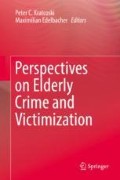Abstract
Statistics on crime reveal that in the United States, as well as in many other countries, the amount of crime reported each year is declining. However, the amount of crime committed by older persons, 65 years and above, has been on a gradual increase. An analysis of trends in the criminality of older persons shows that, although the large majority of crimes committed by the older person are property crimes, older persons are arrested and convicted for almost every type of crime, including violent crime.
In this chapter, the relationship between older victims of crime and their criminal victimizers is examined. The research presented reveals that, in the large majority of personal crimes committed by elderly persons, including murder, assault, rape, and child molestation, the victims were family members, relatives, or close acquaintances. In the cases of property crimes in which older persons were victimized, in the large portion of the cases, the offender was not elderly and was a family member, relative, or friend. This was much lower than that found for the crimes against persons. Elderly persons who are victims of Internet crimes and hate crimes are victimized by a stranger in the large majority of the cases.
Access this chapter
Tax calculation will be finalised at checkout
Purchases are for personal use only
References
Administration on Aging, Administration for Community Living. (2015). p. 1. Retrieved November 5, 2015, from www.aoa.acl.gov/aging_statistics/index.aspx
Bachand, D., & Chressanthis, G. (1988). Property crime and the elderly offender: A theoretical and empirical analysis, 1964-1984. In B. McCarthy & R. Langworthy (Eds.), Older offenders: Perspectives in criminology and criminal justice (pp. 76–103). New York: Praeger.
Black, M., Basile, K., Breiding, M., Smith, S., Walters, M., Merrick, M., et al. (2011). The national intimate partner and sexual violence survey 2010 summary report. Retrieved July 25, 2017, from http://www.cdc.gov/violenceprevention/pdf/risvs_report2010-a.pdf
Federal Bureau of Investigation (1985) Crime in the United States, 1985. Washington, DC: U.S. Government Printing Office.
Federal Bureau of Investigation (1990). Crime in the United States 1990. Washington, DC: Government Printing Office.
Federal Bureau of Investigation. (2014). Hate crimes-2014, tables/table 1. Retrieved August 13, 2017.
Federal Bureau of Investigation (2015). Crime in the United States 2015. Washington, DC: Government Printing Office.
Federal Bureau of Investigation. (2016a). Hate crimes-2015, table 1. Retrieved August 1, 2017, from http://ucr.fbi.gov/hate-crime/2015/tables-and-declarations/1tabledatadcpdf
Federal Bureau of Investigation. (2016b). Hate crimes-2015, table 2. Retrieved August 1, 2017, from http://ucr.fbi.gov/hate-crime/2015/tables-and-declarations/2tabledatadcpdf
Government Accounting Office (GAO). (2010). Guardianships: Cases of financial exploitation, neglect, and abuse of seniors. Retrieved August 12, 2017, from http://www.gao.gov/products/GAO-10-1046
Harrell, E. (2015). Victims of identity theft, 2014 (pp. 1–13). Washington, DC: Bureau of Justice Statistics, Department of Justice.
Kratcoski, P. (1988). An analysis of the victim/assailant relationship in non-justificable homicides by elderly offenders. Trends in law and mental health (F. Koenraadt & M. Zeegers (Editors). Utrecht, The Netherlands, Gouda. pp: 247–255.
Kratcoski, P., & Walker, D. (1988). Homicide among the elderly: Analysis of the victim/assailant relatioship in older offenders. Older offenders prespectives in criminology and criminal justice. N.Y. Praeger.pp:62-75.
Kratcoski, P. (1992). An analysis of cases involving elderly homicide victims and offenders. In E. Viano (Ed.), Critical issues in victimology (pp. 87–95). New York: Springer.
Kratcoski, P., & Edelbacher, M. (2016). Trends in the criminality and victimization of the elderly. Federal Probation, 80(1), 58–63.
Mason, B., & Morgan, R. (2013). Crimes against the elderly (age 65 and older) for the years 2003 to 2013. Bureau of Justice Statistics. Retrieved May 11, 2015, from http://www.bjs.gov/index.cfm?ty=pdetails&lid=51.36
National Coalition Against Domestic Violence. (2017). Domestic violence national statistics, pp. 1–4. Retrieved July 25, 2017, from http://domesticviolencestatistics.org/domestic-violence-statistics/
National Crime Prevention Council. (2015). Strategy: Crime prevention services for the elderly, pp. 1–3. Retrieved June 1, 2015, from http://www.nij.gov/topics/crime/elder-abuse/pages/welcome.aspx
National Institute of Justice, (2015). Extent of elder abuse victimization. www.nij.gov/topics/crime/elder-abuse/pages/extent.aspx. Retrieved 5/11/2015
National Institute of Justice (2017). Elder Abuse. U.S. Department of Justice, Office of Justice Programs. https://nij.gov/topics/crime/elder-abuse/Pages/welcome.aspx Retrieved 10/20/2017
National Network to End Domestic Violence. (2015). 14 domestic violence courts national summary. Retrieved July 25, 2017, from http://nnecdv.org/downloads/Census/Dv-Courts2014/DVCOURTS14_NatSummary_Color-2-pdf
Rosay, A. (2016). Violence against American Indian and Alaska Native women and men, National Institute of justice journal 277, Oct (pp. 40–45). Laurel, MD: U.S. Department of Justice.
Shichor, D. (1984). The extent and the nature of law breaking by the elderly: A review of arrest statistics. In E. Newman & M. Gewitz (Eds.), Elderly criminals (pp. 17–32). Cambridge: Oelgeschlager, Gunn & Hain.
Truman, J., & Morgan, R. (2014). Nonfatal domestic violence, 2003-2012. Washington, DC: Bureau of Justice Statistics, U.S. Department of Justice.
Van Dijk, J. (2016). Illuminating the dark figure of crime: Victimization surveys and beyond. Criminology in Europe, 15(3), 4–9.
Zhang, Y. (2013). National crime victimization survey (NCVS). In J. Wilson (Ed.), The Praeger handbook of victimology (pp. 175–177). Santa Barbara, CA: Praeger.
Author information
Authors and Affiliations
Editor information
Editors and Affiliations
Rights and permissions
Copyright information
© 2018 Springer International Publishing AG, part of Springer Nature
About this chapter
Cite this chapter
Kratcoski, P.C. (2018). The Victim-Offender Relationship in the Criminal Victimization of the Elderly. In: Kratcoski, P., Edelbacher, M. (eds) Perspectives on Elderly Crime and Victimization. Springer, Cham. https://doi.org/10.1007/978-3-319-72682-3_6
Download citation
DOI: https://doi.org/10.1007/978-3-319-72682-3_6
Published:
Publisher Name: Springer, Cham
Print ISBN: 978-3-319-72681-6
Online ISBN: 978-3-319-72682-3
eBook Packages: Law and CriminologyLaw and Criminology (R0)

